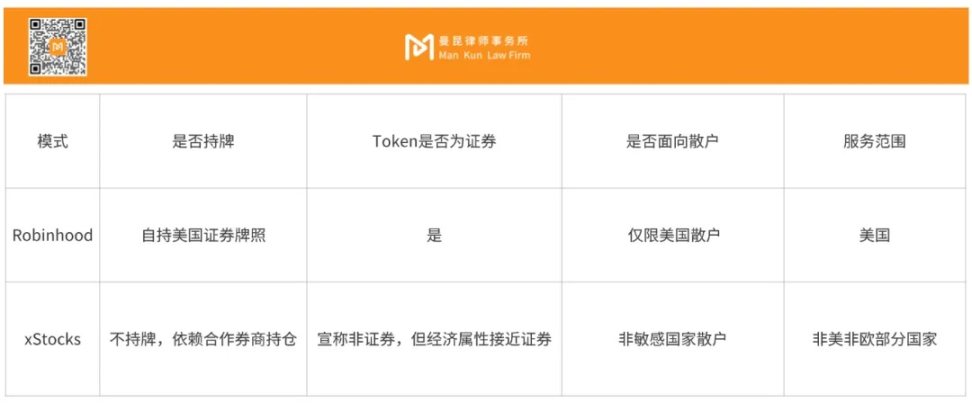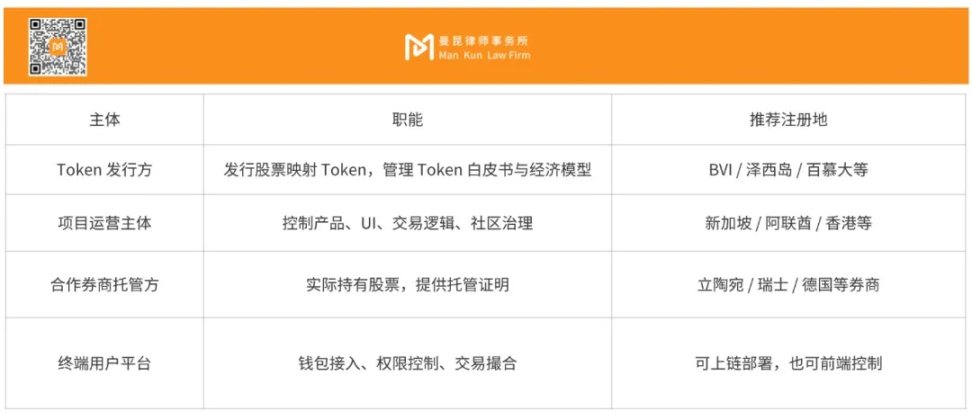If you want to create a stock tokenization platform that allows retail investors to participate and has controllable compliance pressure, how should you proceed?
Written by: Shao Jiadian, Huang Wenjing
Introduction
RWA (Real World Assets on-chain) is rapidly becoming the mainstream narrative in the Web3 world, and one particularly "down-to-earth" direction—Tokenized Stocks—is currently one of the most feasible paths.
The reasons are simple:
The underlying assets are mature enough, requiring no effort to "prove value";
The technical threshold is relatively controllable, with established tools for on-chain issuance and mapping;
The regulatory path is becoming clearer, especially in Europe and some offshore regions, where real projects have already been implemented.
However, many people instinctively think of "stocks" and wonder: Is this a security? Can it be sold to retail investors? Is a license required?
In reality, some projects have found a way to "balance both sides." They can reduce compliance pressure while reaching the retail market, with representative cases being:
Robinhood: The most popular retail securities platform in the United States;
xStocks: A platform for trading stock tokens in non-EU, non-US regions, allowing on-chain buying and selling.
As a lawyer focused on Web3 compliance, I have also started receiving similar inquiries frequently:
How does a stock tokenization platform actually operate?
Do small and medium-sized teams like ours have a chance to do this?
If we want to proceed, where should we start, and how should we structure it to be legal?
This article will not use grand terms or elaborate concepts but will focus on answering one question:
If you want to create a stock tokenization platform that allows retail participation and has controllable compliance pressure, how should you do it?
Robinhood Model: The Ultimate Productization of Retail Securities Trading
Robinhood is not a traditional on-chain platform, but its operational model is highly instructive for Web3 product design.
1. Core Features:
Minimalist interface, eliminating complex terminology from traditional brokers;
Zero commission, no minimum deposit, directly serving retail investors;
All securities clearing and custody are handled by partner institutions;
2. Registration and Compliance Structure:
Robinhood Markets Inc. is established in Menlo Park, California, USA;
Subsidiaries Robinhood Financial LLC and Robinhood Securities LLC hold relevant US securities trading licenses and are subject to dual regulation by the SEC and FINRA;
In addition to securities business, Robinhood also has subsidiaries in the UK and other regions providing cryptocurrency asset services, but its stock trading services are explicitly not open to non-US users.
3. Reasons for Regional Restrictions:
Robinhood only serves the US market for two main reasons:
Opening securities trading to overseas users would require navigating complex securities sales licensing and registration obligations in regions like the EU, Canada, and Japan;
Localized strong regulatory trends exist in various securities regulations, making compliance costs high and risks uncertain for overseas expansion.
xStocks Model: Token Mapping of Real Stocks + Non-Security Declaration + Retail Focus
xStocks is one of the few platforms that has turned "stock price mapping" into a token and offers trading, allowing retail participation while deliberately avoiding the securities classification red line.
1. Core Structure:
Each xStock Token is mapped 1:1 to a stock, actually held by a broker or custodian;
Tokens do not confer voting rights, dividend rights, or governance rights, and the platform does not promote them as "securities";
The platform adopts an "automatic reinvestment" structure for "dividends" to token holders, meaning: if the stock pays dividends, the user's wallet will not receive cash but will instead receive an equivalent increase in tokens;
Users must complete basic KYC, and tokens can be traded on-chain, but access is not open to users from highly regulated jurisdictions.
2. Entity Structure and Registration:
The issuer of the tokens is Backed Assets (JE) Limited, registered in Jersey, which is not part of the EU and is not directly bound by MiCA or Prospectus Regulation;
The service entity is Payward Digital Solutions Ltd., registered in Bermuda, which is in a loosely regulated financial zone;
xStocks products are issued by non-US entities, deliberately avoiding the applicability of US laws.
3. Prohibited Regions and Restriction Logic:
xStocks explicitly states that it does not provide services to the following countries or regions:
The United States (including all U.S. Persons), EU member states, the UK, Canada, Japan, and Australia.
The reasons are:
These regions have extremely strict regulations on securities issuance; if xStocks were to sell locally, it would likely be classified as illegal securities issuance;
The platform has not obtained licenses or compliance exemptions in these regions, thus actively avoiding regulation through IP restrictions and KYC limitations;
The choice to register the issuing entity in Jersey and Bermuda is also a common strategy to reduce compliance risks.
The Essential Differences and Common Insights Between the Two Models

The two paths essentially represent two different logics:
Robinhood: "Doing securities within the regulatory framework"
xStocks: "Avoiding securities regulation through structural design"
Entrepreneurs do not have to choose sides; instead, they should learn how these platforms use legal structures, technical paths, and compliance isolation to create platforms that are "launchable, scalable, and non-risky."
If you really want to create one, how should you structure it?
Stock tokenization is not as simple as copying a contract; you need to design the following roles at a minimum:

The key is:
The platform is responsible for "price mapping + token issuance + user interaction";
Partners are responsible for "holding positions + reporting + risk isolation";
Both parties interact through agreements and information synchronization mechanisms, but regulatory responsibilities are clearly separated.
What institutions need to be involved, and what agreements should be signed?
Stock tokenization is not an isolated system; it must rely on the following resources for interaction:
1. Partners:
Licensed brokers (responsible for real stock custody or trade execution);
Blockchain issuance platforms and technology providers (deploying contracts + permission control modules + oracles);
Legal advisors (token classification analysis, structural design, user agreements);
KYC/AML service providers;
Smart contract auditors.
2. Agreements to be signed include:
Token issuance white paper + legal disclosure statement (Offering Terms);
Asset custody service agreement / custody proof (Custodial Agreement);
Platform user agreement + risk disclosure statement (T&C);
Compliance service integration agreement (KYC, IP blocking, etc.);
Documentation for token and platform interaction contracts.
Several points you may not have realized but must consider
If these points are overlooked, the consequences will not be community FUD but real regulatory actions:
Tokens must not confer any "profit promises," "governance rights," or "claims rights";
Do not open access to users from high-sensitivity jurisdictions like the EU, US, and Japan;
Avoid using terms like "stocks," "shareholder rights," or "dividends";
Must control regions and identities through both technology and agreements;
Be prepared with legal classification opinions, risk disclosure statements, and KYC audit records for reference.
Whether you can do it does not depend on licenses but on structure
Stock tokenization is a feasible project direction that requires careful design. It is neither as "unregulated" as NFTs nor as "rule-bound" as traditional securities. What you need to do is not to make radical breakthroughs but to:
Find a suitable landing point
Design a clear structure
Clarify what your tokens represent
Avoid touching the three red lines of users, markets, and laws
This market is not saturated; rather, it is in a gap where institutions are cautious but interested, and entrepreneurs are interested but hesitant to enter. Stop looking at what others have done. The stock tokenization track is not yet crowded; once it is occupied by giants, you will only be a user.
免责声明:本文章仅代表作者个人观点,不代表本平台的立场和观点。本文章仅供信息分享,不构成对任何人的任何投资建议。用户与作者之间的任何争议,与本平台无关。如网页中刊载的文章或图片涉及侵权,请提供相关的权利证明和身份证明发送邮件到support@aicoin.com,本平台相关工作人员将会进行核查。




